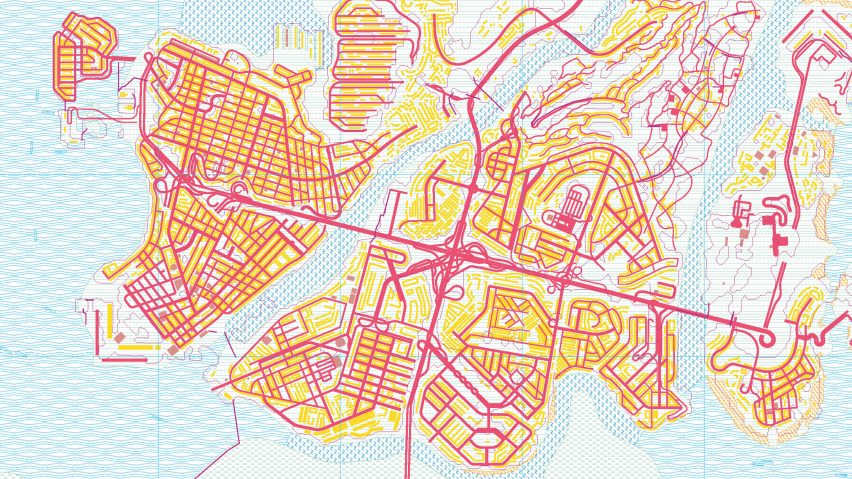Panoramic maps, playful diagrams and layered illustrations feature in Videogame Atlas, a book by research studio You + Pea that highlights the use of architecture in video games.
Videogame Atlas, which was released as a special edition on Volume, provides detailed and playful insights into the virtual environments through the style of drawings typically found in 20th-century architecture publications.
The book breaks down the worlds of video games including Assassin's Creed: Unity, Cities: Skylines, Dark Souls, Death Stranding, Dwarf Fortress, Final Fantasy VII + Remake, Fortnite, Katamari Damacy and Minecraft.
"The book aims to analyse the worlds of video games in the same way we would look at cities and environments in the physical world, as places that hold deep meaning for their inhabitants," You + Pea founders Sandra Youkhana and Luke Caspar Pearson told Dezeen.
"We wanted to understand not only how games might take inspiration from real places and shape them in new ways, but also how player communities have invented their own ways of seeing and interacting with these worlds," the pair added.
You + Pea explores video-game technologies in architecture and also leads The Bartlett School of Architecture's Videogame Urbanism studio. According to the studio, architecture plays an important role in creating immersive experiences in video games.
"In many cases, architecture is extremely important. Dark Souls uses carefully planned circulation routes, lighting conditions and transitions from tight to open spaces to promote tension in the player," the studio said.
"Architecture also helps to situate the player character in the story and surrounding culture of the world, to create a lifelike and immersive experience but also to signal limits – what we can and cannot do within the world."
As concepts such as digital twins – digitals replicas of buildings and cities – and the metaverse become more common, the interest in digital architecture seems to be increasing.
"Architects are turning to game engines as a way of visualising their projects in real time, and there is also an increasing recognition that game worlds are some of the most primary architectural experiences that people have today," You + Pea said.
"Games can in turn draw from architecture's rich history, to understand how cities and places are formed over time and through multiple cultural influences."
Below, You + Pea choose five important video games and accompanying illustrations from Videogame Atlas:
Assassin's Creed: Unity
"In Assassin's Creed: Unity, late 18th-century Paris becomes a landscape of movement, a compressed city where players are constantly moving across, up, and over buildings. Players can recognise notable monuments and districts, interacting with them as parkour obstacles."
"The game also relies on a historical setting where massed crowds become urban territories in the city – mirroring how the real-world Paris of this era became a key reference point for sociologists studying crowd behaviours."
Cities: Skylines
"Cities: Skylines is a classic city-builder game in the lineage of SimCity, which appears to prioritise an American-style zoned approach to urban design. Yet through its energetic community, the game has been modified and extended in ways that allow many different types of cities to be realised."
"With over 250,000 community mods available for download, alongside countless players' design guides, the Cities: Skylines community has made the relationship between cities and the rules that govern them both more visible and more flexible."
Dark Souls
"The world of Dark Souls is a seminal example of 'picturesque' design in video games. The game sources inspiration from buildings and locations around the world, weaving them together into a beautiful landscape of death and decay made from architectural ruins and fragments."
"Lordran [an area in Dark Souls] is tightly designed around scenic views – endpoints that players must reach through tortuous routes, moving from tightly knit and oppressive spaces into huge arenas of intimidating scale."
Persona 5
"By connecting the minutiae of daily life in Tokyo to the fantastical world of the metaverse, Persona 5 takes the city's compact streets, minimarts and vending machines, reinventing them as amenities for the otherworldly."
"The game faithfully depicts the narrow streets of Tokyo, especially the district of Sangenjaya, an area well documented by fans of the game. The emphasis on domestic-scale space and player growth through everyday activities ties the player's chances of success to how fully they engage with the seemingly mundane aspects of city life."
Stardew Valley
"In Stardew Valley we encounter a natural landscape to be nurtured, square by square. With its gentle lessons in labour, the world demonstrates the value of time – and the impact of bypassing it with automated production."
"As with real-world agriculture, the bucolic fantasy of life on the farm is challenged by the technical ingenuity of players who develop efficient new planting patterns, bee-hive configurations, or visualisation tools to assess and plan future landscape development."
Dezeen is on WeChat!
Click here to read the Chinese version of this article on Dezeen's official WeChat account, where we publish daily architecture and design news and projects in Simplified Chinese.

